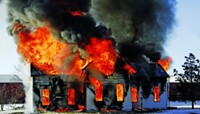Advertisement
Grab your lab coat. Let's get started
Welcome!
Welcome!
Create an account below to get 6 C&EN articles per month, receive newsletters and more - all free.
It seems this is your first time logging in online. Please enter the following information to continue.
As an ACS member you automatically get access to this site. All we need is few more details to create your reading experience.
Not you? Sign in with a different account.
Not you? Sign in with a different account.
ERROR 1
ERROR 1
ERROR 2
ERROR 2
ERROR 2
ERROR 2
ERROR 2
Password and Confirm password must match.
If you have an ACS member number, please enter it here so we can link this account to your membership. (optional)
ERROR 2
ACS values your privacy. By submitting your information, you are gaining access to C&EN and subscribing to our weekly newsletter. We use the information you provide to make your reading experience better, and we will never sell your data to third party members.
Policy
Chemophobia And Fire Safety
by A. Maureen Rouhi
October 29, 2012
| A version of this story appeared in
Volume 90, Issue 44
The furor over flame retardants that preoccupied the public last spring held C&EN’s attention, too. These chemicals are in most homes; they are required for safety reasons. A series in the Chicago Tribune damned the chemicals, alleging that they don’t impede fires and are hazardous to human health. The Tribune also decried—appropriately, I should add—the deceptive tactics of some makers of flame-retardant chemicals. Unsurprisingly, the series fueled the general public’s chemophobic predilection.
At C&EN, we try to bring a distinctly chemistry perspective to events covered by mainstream media. Our inquiry about the efficacy and safety of flame-retardant chemicals appears as three stories in this issue. News Editor William Schulz untangles the arguments in the debate surrounding the draft revision of California’s fire-safety standard for upholstered furniture, which will affect the need for flame-retardant chemicals in furniture fabrics and foam (see page 28). Senior Correspondent Cheryl Hogue details the current and planned actions of the Environmental Protection Agency to scrutinize the chemicals (see page 34). And Senior Correspondent Alex Tullo examines how makers of flame-retardant chemicals are developing safer alternatives to their current products (see page 39).
In fact, California and the European Union have banned some flame-retardant chemicals because they pose unacceptable risks. And EPA is assessing many others for possible regulation. What C&EN’s stories demonstrate, however, is the difficulty of weighing the risks and benefits of chemicals in commerce and how that is exacerbated by insufficient data on safety, different interpretations of efficacy, and the public’s tendency to accept without question chemophobic pronouncements by media-savvy activists.
We should all pay attention to the draft revision of California Technical Bulletin 117 (TB 117), California’s fire-safety standard for upholstered furniture. As Schulz writes, “TB 117 has become the de facto national standard. If California substantially alters or weakens [that] standard … then the same will apply nationwide.”
Proponents of the draft revision want to require the components of furniture sold in California to pass only the cigarette smolder test of the current two-part test, which includes an open-flame challenge. Because furniture makers can use barrier materials to pass a smolder-only challenge, they say that use of flame-retardant chemicals would be unnecessary and should be stopped in light of health and environmental concerns.
Fire-safety experts tell Schulz, however, that the open-flame challenge is “an absolute necessity,” noting that candles, matches, and cigarette lighters are also significant causes of furniture fires.
I am terrified of fires. Growing up, I witnessed two conflagrations so close to home that each time my family had to evacuate. I am for strong fire-safety standards and for furniture makers to have access to all reasonable means to ensure that their products meet stringent requirements.
Many fire-safety experts Schulz interviewed say “tough fire-safety standards force innovation.” And as Tullo reports, the chemical industry has been innovating with alternative flame-retardant chemicals for more than a decade now. The technology that is gaining acceptance is polymeric molecules, developed by producers of flame retardants as well as by Dow Chemical, a consumer of the chemicals.
I support EPA’s moves to review the risks posed by chemicals in commerce and to regulate particular substances if the scientific assessment demands it. As Hogue explains, EPA is assessing flame-retardant chemicals, and as a result of its reviews, the agency may decide to restrict certain substances. EPA, however, must support its decisions with cost-benefit analyses.
Chemical producers should be transparent and make data available about their products’ efficacy, hazard, and toxicity. Only with sound science can we make the objective cost-benefit analyses needed for informed decisions. Only with unassailable data can we even begin to respond to the shrill voices of chemophobia that threaten to undermine fire safety.
Views expressed on this page are those of the author and not necessarily those of ACS.



Join the conversation
Contact the reporter
Submit a Letter to the Editor for publication
Engage with us on Twitter